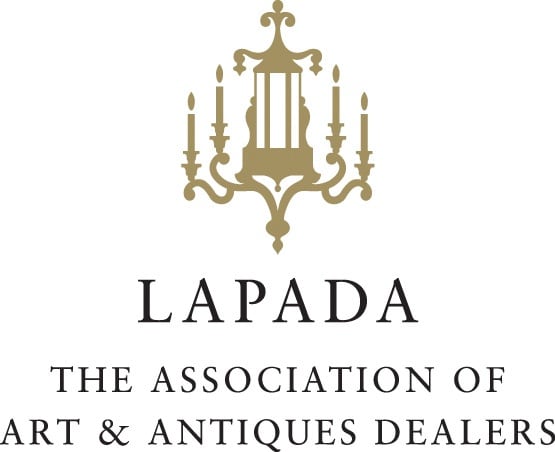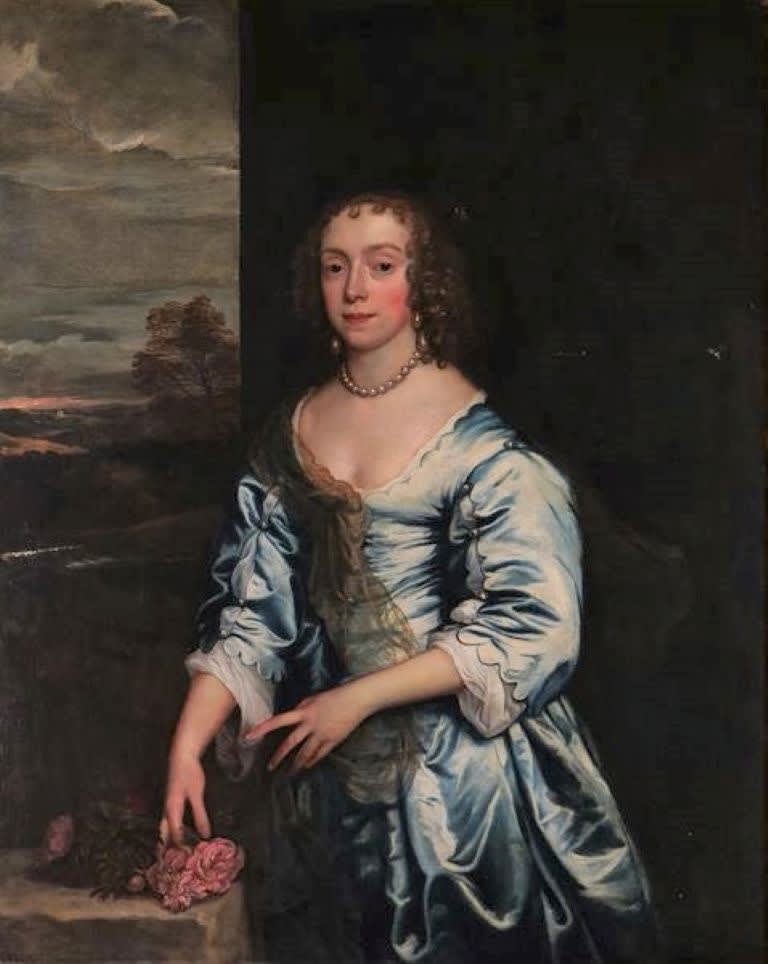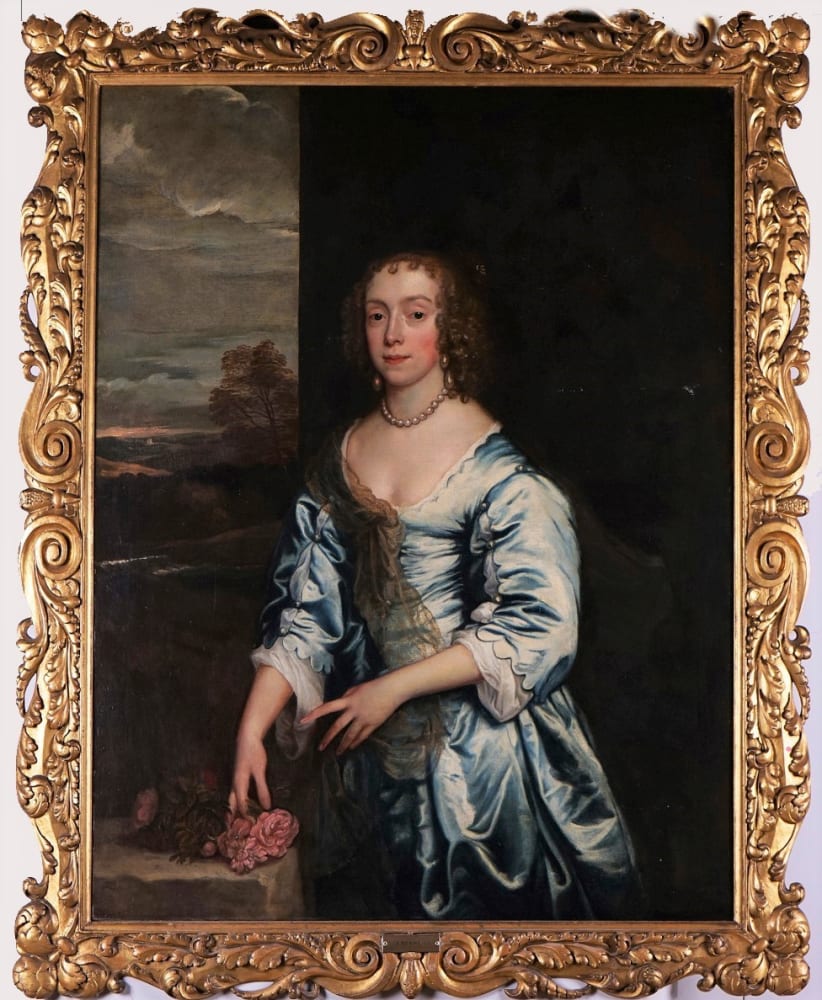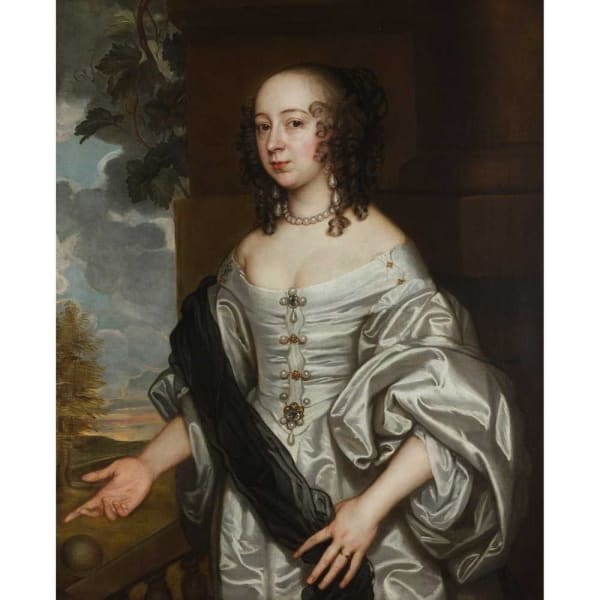Circle of Sir Anthony Van Dyck (1599-1641)
Provenance
With Lane Fine Art, London by 2001
Private collection, Sussex
Literature
Christopher White, 'Anthony Van Dyck and the Art of Portraiture', 2021
Portrait of Anne Berney (d.1762), by an artist in the circle of Sir Anthony Van Dyck (1599-1641), wearing a sumptuous blue silk gown with scalloped edged neckline and sleeves, a gauze shawl over one shoulder, and a pearl necklace and earrings, standing on a garden terrace. She is shown tending to some flowers on a stone pedestal, perhaps symbolising her youth and readiness for marriage. c. 1640.
Oil on canvas in an English carved and gilded 'Sunderland' frame.
The portrait is believed to be of Anne (c.1590-1652), daughter of Michael Smallpage of Chichester and wife of Sir Richard Berney (1st Baronet) of Park Hall, Reedham in Norfolk (d.1668). Richard Berney was made a baronet in 1620 by James I and soon after became the High Sheriff of Norfolk.
Similarities in the style of Anne's clothing can be drawn with the portrait of Lady Mary Villiers as St Agnes, who wears a scalloped hemmed silk gown, painted by Van Dyck in c.1637 (Royal Collection), and of Van Dyck's wife, Mary Ruthven, Lady Van Dyck in 1640 (Prado, Madrid) who wears a similar blue gown with scalloped edged sleeves. The portrait of Mary Ruthven prompted William Sanderson's remark about the 'careless romance' in contemporary female costume created by Van Dyck. Compared with the more limited costume worn by Van Dyck's Continental sitters, the dress of his English subjects was greatly varied. He introduced the notion of 'undress' which gave his sitters a new, alluring appearance and he sought a timelessness by avoiding specific detail and mixing the real with the imaginary.
Anthony Van Dyck (Antwerp 1599-1641 London) was the most important Flemish painter of the 17th century after Rubens, whose works influenced the young Van Dyck. He also studied and was profoundly influenced by the work of Italian artists, above all, Titian. Van Dyck was an extremely successful portraitist and painter of religious and mythological pictures in Antwerp and Italy. He was also an accomplished draughtsman and etcher. However, he is now best remembered for his elegant representations of Charles I and his court.
Van Dyck was born in Antwerp. A precocious artist, his first independent works date from 1615-16, when he would have been about 17. In 1621 he was in the service of James I of England, but left to visit Italy, where he remained until 1627. His aristocratic rendering of Genoese patricians, like the so-called 'Balbi Children' (c.1627, National Gallery London), were very well received in that city. After a second period in the Netherlands, greater success awaited Van Dyck when he settled at the English court in 1632. His authoritative and flattering representations of Charles I and his family set a new standard for English portraiture to which members of the court were keen to aspire.
(ref, National Gallery, London)
Join our mailing list
* denotes required fields
We will process the personal data you have supplied to communicate with you in accordance with our Privacy Policy. You can unsubscribe or change your preferences at any time by clicking the link in our emails.
Old master, British and European paintings and sculpture from the 16th To 19th century


+44(0)7984 699799 CONTACT@ISHERWOODFINEART.COM
This website uses cookies
This site uses cookies to help make it more useful to you. Please contact us to find out more about our Cookie Policy.





